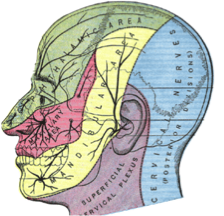|
A headache is a perception of pain in the head, and can have a variety of causes, from stress and tension (the most common) to bacterial infections and tumors (rare), and even the over-use of some medications. Many are not well understood. However, many headaches involve something known as referred pain, or pain felt in a location different from its origin. For example, some headaches actually originate from neck or shoulder problems.
Tension-type headaches often come after stress and fatigue. People used to think they were caused by muscular tension, but new studies suggest that it might be the other way around; pain receptors activated in the head, neck, and shoulders can result in muscle tenderness. Over-sensitive pain receptors can start interpreting normal sensations as pain, and the headache can become chronic. We are still not sure what causes these pain receptors to be active in the first place. Migraines are recurring and very painful headaches that are often one-sided, last less than 72 hours, and can induce nausea and sensitivity to light or sound. Today, many scientists believe migraines are caused by a “wave” of activity in the brain (of unknown origin) that eventually activates pain receptors in the trigeminal nerve, a nerve responsible for transmitting touch and pain signals from the face. This spreading wave of abnormal brain activity is known as cortical spreading depression.
0 Comments
Leave a Reply. |
Archives
June 2022
|

 RSS Feed
RSS Feed